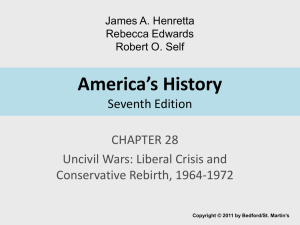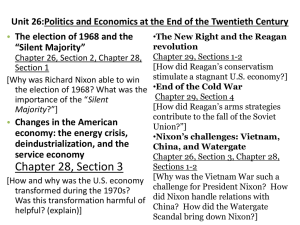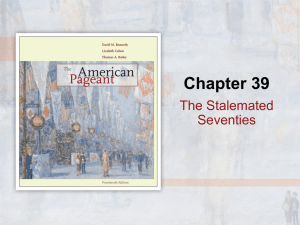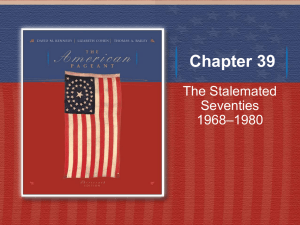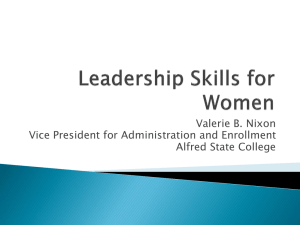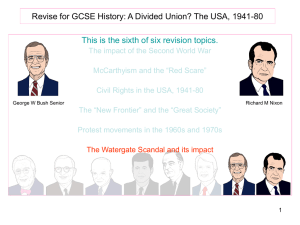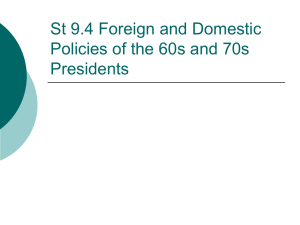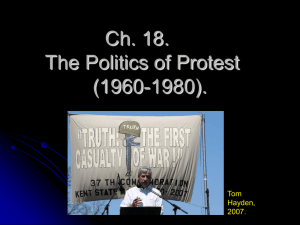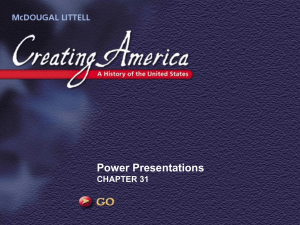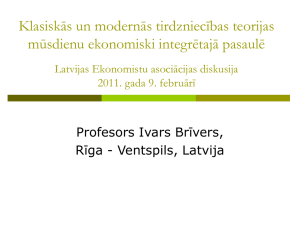Nixon`s Administration Powerpoint Notes
advertisement
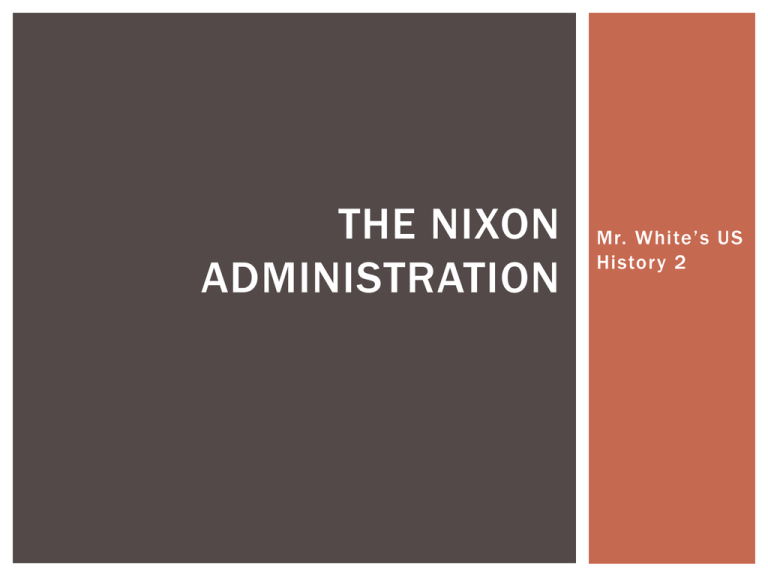
THE NIXON ADMINISTRATION Mr. White’s US History 2 MAIN IDEA AND OBJECTIVES Main Idea: President Richard M. Nixon tried to steer the countr y in a conser vative direction and away from federal control . Big Question: What makes an ef fective, successful leader? Af ter we finish this section, we should be able to: Describe Richard Nixon’s political philosophy and approach to the federal government Explain Nixon’s Southern strategy to win re-election Describe Nixon’s efforts to fix problems of the United States economy Evaluate Nixon’s successes in foreign policy PART I: NIXON’S NEW CONSERVATISM Nixon’s administration laid the groundwork for the modern conservative movement NEW FEDERALISM One of Nixon’s main goals as president was to decrease the size and influence of the federal government – small government conservatism Nixon believed that Lyndon Johnson and Kennedy’s social programs over-extended the government’s power Nixon felt much of this power should go to the states Nixon instituted a policy of revenue -sharing – federal money given to the states could be spent any way the states wanted FAMILY ASSISTANCE PLAN As part of Nixon’s ef forts to decrease the size and influence of the federal government, he addressed the social welfare system Nixon Proposed the Family Assistance Plan: Families of four with no income could receive federal support in a fixed amount Unemployed participants would have to take job training, accept any reasonable work offered, as part of the program Nixon’s plan passed the House of Representatives, but not the Senate Liberals – Program was too stringent, didn’t offer enough money Conservatives – Opposed guaranteed income BUILDING AND DISMANTLING Nixon strengthened some federal programs to win support for other things that he wanted Supported increased spending for Social Security, Medicare, Medicaid, and made food stamps more accessible At the same time, he worked to dismantle other programs: Opposed the Job Corps and additional funding for Housing and Urban Development Used “impoundment” to try to underfund programs, but federal courts ordered him to stop Abolished the Office of Economic Opportunity TWO PROMISES Nixon had made two campaign promises: to de -escalate the U.S. involvement in Vietnam, and to bring law and order to American society – end protests, riots, moral decay Nixon did begin the de -escalation of the war in Vietnam (Vietnamization), and also oversaw peace talks between the two sides To bring law and order to the U.S., Nixon and his administration used many resources, some illegal, to keep an eye on political opponents Wire-tapping, CIA investigations, IRS audits Created a personal “enemies list” PART II: NIXON’S SOUTHERN STRATEGY Nixon’s “Southern Strategy” was policy that he designed to win support for him in the southern states THE SOUTHERN STRATEGY As Nixon had only won the 1968 election with a slight majority, he created his Southern strategy to attract southern conservative voters De-segregation policies of the federal government weren’t popular with southern democrats Also promised to name a southerner to the Supreme Court Governor George Wallace opposes federal de-segregation in Alabama. THE NEW SOUTH Since the end of the Civil War, the south had been a strongly Democratic region But the liberal policies of Truman, Kennedy, and Johnson (all Democrats, and all who favored de-segregation to some degree) had angered many southern Democrats George Wallace, a presidential candidate in the 1968 election, had won a handful of southern states as an independent candidate, using a pro-segregation platform Nixon hoped to attract many of these same voters NIXON SLOWS DESEGREGATION Nixon first decided to slow the country’s desegregation 1969 – Ordered the Department of Health, Education, and Welfare to delay desegregation in South Carolina and Mississippi This violated the Supreme Court’s ruling in Brown v. Board of Education (desegregate “with all deliberate speed”), and Nixon was ordered to abide by this Nixon also opposed: Voting Rights Act of 1965, but Congress successfully extended it Busing urban children to different schools to desegregate them – it continued in many cities NIXON’S SUPREME COURT Nixon also worked to influence the Supreme Court Felt that the Warren Court was too liberal, especially in racial policies Four justices retired from the Supreme Court, and Nixon appointed justices to make the Court more conservative The Court did not always follow what Nixon wanted – ruled in 1971 that schools could be racially integrated by busing PART III: A STAGNANT ECONOMY Nixon’s administration confronted an economy with high inflation and high unemployment A TROUBLED ECONOMY As the prosperity of the 1950s and 1960s wound down, the economy began to have many problems High unemployment, high inflation – known as “stagflation” What caused these problems? LBJ’s spending for war and social programs Increased international competition, flood of workers in the workforce Heavy dependence on foreign oil – price fluctuations NIXON’S REMEDIES Nixon tried to solve these problems by: Raising taxes and cutting the budget – Congress didn’t go for this Urging an increase in interest rates – didn’t really work, drove country into recession Froze workers’ wages and business prices and fees for 90 days – inflation eased slightly, but the recession continued PART IV: NIXON’S FOREIGN POLICY TRIUMPHS Nixon’s administratio n had many successes in the area of foreign policy NIXON’S FOREIGN POLICY AND REALPOLITIK Nixon said that he very much wanted to focus on foreign issues in his presidency Gain an honorable peace in Vietnam Better relationships with China and the Soviet Union Henry Kissinger, Nixon’s Secretary of State, helped him develop his foreign policy Realpolitik – foreign policy should be based on power, not ideals or moral principles If a country is weak, ignore it If a country is strong, deal with it accordingly The previous policy of containment had refused to recognize communist nations KISSINGER, NIXON, AND DÉTENTE Kissinger and Nixon adopted a more flexible approach to communist nations Détente – openness designed to ease Cold War tensions In 1972, president Nixon exercised this policy when he visited China ONLY NIXON COULD GO TO CHINA W h e n C h i n a we n t c o m m unist i n 1 9 4 9, t h e Un i te d St a te s h a d re fus e d to re c o g niz e i t – N i xo n reve r sed t h i s N i xo n we n t to C h i na to t r y to bet te r re l a t ions bet we e n th e U. S. a n d C h i na , a n d a l so i n c re ase t h e di v ision bet we e n C h i n a a n d t h e U . S. S. R . , C h i n a’s a l l y a n d t h e U . S. ’ s ri va l W h e n N i xo n a rri ved i n C h i n a, h e m a de i t a po i n t to pe r s on ally do t h i n gs to t h aw re l a t ions Th i s re s ul te d i n m a ny i m po r ta nt a g re e ment s bet we e n t h e U n i te d St a te s a n d C h i na No domination of the Pacific, cooperation in settling disputes, scientific and cultural exchanges, reuniting Taiwan to mainland China Nixon shakes hands with Chinese leader Chou En Lai, upon his arrival in China. NIXON IN THE U.S.S.R. Nixon also travelled to the U.S.S.R. to try to thaw relations there Nixon and Leonid Brezhnev signed the Strategic Arms Limitation Talks (SALT) Treaty Both countries agreed to not increase their ICBM and submarine-launched missiles Nixon was able to use these successes with China and the Soviet Union, plus the approach of peace in Vietnam, to win re-election in 1972 MAIN IDEA AND OBJECTIVES Main Idea: President Richard M. Nixon tried to steer the country in a conservative direction and away from federal control. Big Question: What makes an effective, successful leader? After we finish this section, we should be able to: Describe Richard Nixon’s political philosophy and approach to the federal government Explain Nixon’s Southern strategy to win re-election Describe Nixon’s efforts to fix problems of the United States economy Evaluate Nixon’s successes in foreign policy WRAP-UP Complete the sentence! One of Nixon’s main goals for his presidency was to… Nixon adopted his Southern Strategy in order to… One part of Nixon’s Southern Strategy was to… One of the problems that the U.S. economy was facing was… One of the ways that Nixon tried to fix the economy was to… One of Nixon’s successes in foreign policy was…
